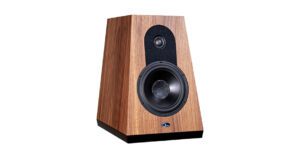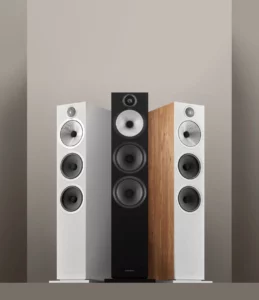
For the longest time, Audio Research was synonymous with brushed aluminium cases with slimline black handles. When, several years ago, the company shifted to larger brushed aluminium handles and an all-black finish option, the company’s many followers got enraged. A few years later, when the company started including a black inset and push buttons instead of toggle switches, the ARC supporters were incandescent. So, with the arrival of the new Audio Research I/50, its six colour options of black or silver casework and four – often contrasting – top plates, those traditional fans should be going thermonuclear. However, the I/50 isn’t for the traditional Audio Research fans; it’s for a new generation of listeners, who might have little or no previous experience with Audio Research and are just looking for a damn good integrated valve amplifier.
In fairness to Audio Research’s cognoscenti, the arrival of the I/50 appears to have been met with some encouragement. This isn’t a sovereign threat to Audio Research’s DNA; it’s a new addition to the family, presaging a new generation of Audio Research listeners. The amp is seen – rightly – as a new direction without sabotaging what’s already good about Audio Research.
The basics
While the styling is a bold departure for the brand, the I/50 is every inch an Audio Research design. It uses a trio of 6922 tubes in the preamp stage (one as input and the other two as drivers), which feed into two matched pairs of 6550WE power tubes to deliver 50W per channel. The tubes are expected to give 4,000 and 2,000 hours respectively before they need replacement and that needs to be performed by a dealer (the power valves/tubes will need bias fine tuning and that requires getting into the internals of the I/50). Controls are limited to power, source selection, volume and mute on the top panel of the amp, but additional functions – including balance and display brightness – are handed off to the remote handset. The I/50 has three line and one set of balanced inputs as standard – with one of the single-ended inputs able to be configured as a home cinema pass-through input. Single-ended input one can be replaced by a MM/MC phono module, and there is provision for an additional DAC module that includes coaxial and TOSlink S/PDIF and USB inputs. There are multi-way outputs for four and eight ohm loudspeakers at the rear of the Audio Research I/50 and a 6.25mm headphone jack socket on the top plate. There are no preamp or tape-loop outputs.
The point of inflection between ‘engineering’ and ‘industrial’ design is the unique ‘LexieTube’ display. These stand in front of the array of tubes, giving an elegant ‘4:3:2’ formation (rather like a football team that’s had one of its midfielders sent off). LexieTubes stand about as tall as the 6922 tubes, have a green dot-matrix display that shows volume and input selection, and are reminiscent of the cold-cathode ‘Nixie’ display tubes that were popular from the 1950s to the 1970s. And that design-driven ‘retro chic’ is a big part of what the I/50 is all about.
The joy of Six
You can buy your Audio Research I/50 in one of six colour-ways. For Audio Research traditionalists, there ‘natural’ (brushed aluminium with a matching grey top-plate), while the other five all sport black casework with either a bright red, gold (I’d call it more a ‘creamy yellow’… but it looks good in the flesh), white, black or blue top plate, all with a contrasting black central insert. The colour of the top plate extends to little rings around the tubes and the LexieTubes. This is a very clever design as it retains many ‘retro’ cues without being too ‘homage’ or even a pastiche. You aren’t buying a 70 year old amplifier; you’re buying a modern amp with just the right kind of retro touches.
This speaks to a new audience; a cash-rich, time- and space-poor group a generation or two younger than traditional audiophiles. They want great performance without the ‘faff’ of lots of boxes and endless demonstration sessions. They are likely metropolitan apartment (flat) dwellers in their 30s and 40s and the audio world has (understandably, but somewhat erroneously) largely dismissed them as ‘personal audio buyers’. The pandemic and the post-pandemic world changed all that, and that generation are looking beyond the headphone socket now. They are still uninterested in knowing the chemical composition of equipment feet, what brand of resistor is used, or the astrological star-sign of the designer, but that doesn’t make them any less discerning, as the I/50 ably demonstrates.
Analysis Paralysis
So let’s get the downsides out of the way first. If a multiplicity of colour options give you a touch of ‘analysis paralysis’, remember these are not interchangeable colour-ways; what you buy today is what you live with. Also, if you are expecting to use the I/50 as a platform for upgrading, or to drive difficult loudspeaker loads at high volumes you are looking in the wrong direction. That’s not what the Audio Research I/50 is about.
Instead, what this is about is a breath of fresh air in the often stuffy halls of audiophilia. Partner this with a decent turntable and a streamer of some sort (or maybe a laptop if you opt for the DAC) and hook it to some good loudspeakers (it was designed with Wilson Audio SabrinaX in mind), and you have a system that doesn’t make you look to the next upgrade or hyper-scrutinise your music. It just sticks a smile on your face. Sure, it’s a fun machine and the first listening sessions could be a protracted dance through your music collection. But people often complain that once that honeymoon period is done, the equipment tends to sit unused. That just won’t happen with the I/50; it’s so musically engaging and fun, it will be the centrepiece of your music listening for years to come.
It seems inappropriate to play Old Git Music through the I/50. While the Audio Research sounds great with bands where the survivors hate one another (Pink Floyd, The Eagles), that’s not what its demographic is going to play; instead, I played For Emma, Forever Ago by Bon Iver [4AD] and Post To Wire by Richmond Fontaine [El Cortez]. These indie folk/Americana master-works from the later 2000s are far more likely to get airtime through the I/50 and they sound wonderful, if a little gloomy (as they should).
I made the mistake of turning the I/50 off at what I thought was the end of a session and immediately regretted it. I wanted to play some more Stormzy (I’d played Heavy Is The Head and wanted to try the more downbeat This Is What I Mean album). The I/50 gives you a three-minute time-out between power-ups (and a 50 second countdown from cold). Those three minutes were like an hour’s wait, so keen was I to start playing again. That’s what the I/50 does so well and how it makes you feel.
There are two key points defining what makes the I/50 sound so good; a lifelike vocal projection and articulation and a soundstage that is as holographic and inviting as the recording and speakers allow. These are perhaps the reason the Audio Research of old is in very safe hands in the shape of the I/50; these a key performance aspects of most Audio Research products and are echoed here. I’d even go so far as to suggest the reduction of that characteristic brightness and slight forward presentation of modern Audio Research designs makes the I/50 universally attractive.
A Storm(zy) is brewing
I realised that broken Stormzy session defined what makes the Audio Research I/50 so alluring. He’s not universally popular in the Sircom household. So, imagine my surprise when I heard ‘Vossy Bop’ being played by my wife. She’s never been ‘into’ Stormzy (she’s more into Burial and Lethal Bizzle) but started to enjoy his music through the Audio Research I/50. Yes, some of that comes down to the clarity, articulation and staging of the amp, its unforced dynamics and excellent overall tonal balance that is a perfect foil for the kind of loudspeakers a 50W amp that costs below £6,000 might partner.
I got the negatives out of the way early here, but there is another negative; no matter how good I make this sound, it’s understatement. Even if I filed copy that was so enthusiastic and rosy it read like fan fiction, it would still be playing down the I/50. Sure, some of that is entailed within the whole ‘new markets’ concept that I think is both the right new direction for the brand and, in a wider context, the whole audio industry. But if Audio Research just made another nice amp in a new box, it would be good… but it wouldn’t be I/50 good.
It’s probably no surprise that I’m deeply impressed by the Audio Research I/50 integrated amp. It’s an amplifier that anyone could live with and enjoy. Sure, there’s a lot more upmarket amplifier designs around, but many of them are just ‘more’ not ‘better’. The I/50 does ‘better’ superbly and that it combines good looks and a sound that is easy to like and extremely easy to live with all results in an amplifier that is as important as it is sonically great. I’m going to struggle to give this one back!
Technical specifications
- Power Output 50 watts continuous from 20Hz to 20kHz
- total harmonic distortion @1kHz typically below 0.1% at 1 watt
- Power Bandwidth (-3dB points) 10Hz to 22kHz
- Frequency Response (-3dB points at 1 watt) 7Hz to 30kHz
- Input Sensitivity 1.25V RMS for rated output.
- Input Impedance 100K ohms Balanced, 48K ohms Single Ended
- Output Polarity Non-inverting. Balanced input pin 2+ (IEC-268)
- Output Taps 8 ohms, 4 ohms
- Tubes Required 2 matched pair 6550WE; 3–6922
- Dimensions (W×H×D) 42×18×34cm
- Weight 18.1kg
- Price £6,998, phono module £898
Manufacturer
Audio Research
UK distributor
Absolute Sounds
+44(0)20 8971 3909
By Editor
More articles from this authorRead Next From Review
See all
PrimaLuna EVO 100 phono preamplifier
- Apr 22, 2024

Reiki Audio SuperSwitch Master Pro + Servant Pro
- Mar 27, 2024

Melco Audio N1-S38 music server
- Mar 27, 2024











